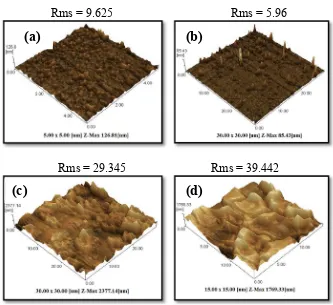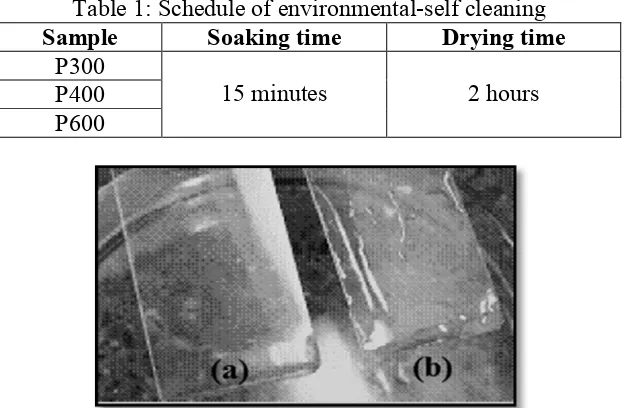Effect of PEG Molecular Weight on the TiO
2Particle Structure and TiO
2Thin Films Properties
M. Zainab
1, a, A.R. Jeefferie
1, b, A.K. Masrom
2, cand Z. M. Rosli
1, d1
Engineering Materials Department, Faculty of Manufacturing Engineering, Universiti Teknikal
Malaysia Melaka, Malaysia
2
Industrial Nanotechnology Research Centre, SIRIM Berhad, Malaysia
a
[email protected], [email protected], [email protected],
d
Keywords: TiO2 thin films; Polyethylene glycol (PEG); Sol-gel method; Dip-coated
Abstract. This research, deals with modification of sol gel process for the synthesis of porous TiO2
-PEG thin films with good structural integrity for environmental self-cleaning applications. Relatively, by adding the PEG with various molecular weights (300, 400, and 600) could influence the formation of TiO2 films structure and adhesion. Moreover, the formation of porous TiO2
associated with larger pores will accelerate the mass transfer of the treated contaminants in the larger pore channels. The advantages of the unique structures of as-prepared TiO2₂ films in the
application of environmental self-cleaning systems are extensively studied by characterizing the produced films using various advanced characterization tools. Adhesion of TiO2 thin films become
smooth and better surface with increasing the coating layers. The X-ray Diffraction spectrum of prepared coating shows present of anatase phase as major phase.
Introduction
The main aim of this research is to study the effect of polyethylene glycol (PEG) molecular weight addition via sol-gel process on the TiO2 particle structure and TiO2 particle size.
Polyethylene glycol (PEG) has been frequently used as a structure-directing reagent to obtain nano porous SiO2, TiO2, Al2O3 and other advance ceramic materials [1]. Preparation of TiO2 thin film
coating by immobilized TiO2 nano particles on the surface of various substrates are carry out by the
sol gel method [2]. TiO2 prepared by sol-gel method can yield nano size TiO2 and when
immobilized into a thin film coating will be able to produce relatively thick nano structured TiO2
films that can enhance the photocatalytic activity. In corporation of additive such as PEG into a precursor mixture during production of titania sol, it is expected to improve coating characteristic of the TiO2 thin film and will lead to good mechanical stability of the thin film [3, 4, 5].
This research carry out the synthesis of TiO2 nanocrystalline thin films method by modified the
sol-gel deposited TiO2 films. Anatase TiO2 films have been obtained by adding PEG as a pore of
templating agent. For better understanding of the nature of the influence of PEG on film crystallization, sol-gel solutions were prepared in the presence of PEG of different molecular weight (300, 400 and 600). Furthermore, the produced samples will be explored, by understanding the characteristic of thin films utilizing various advanced characterization tools.
Methodology
Preparation of TiO2 films uses several types of chemicals which are titanium isopropoxide
(TTIP, 97%, Aldrich), polyethylene glycol with molecular weight of 300, 400, 600 (PEG, Aldrich), acethylacetone (99.5%, Aldrich), propanol and acid hydrochloride (HCL 36.5%). Glass slides were used as coating support for photocatalytic films. Overall, there are three major experimental procedure involved. These include the preparation of titania sol, preparation of glass slide and preparation of TiO2-PEG films. Titania sol was differentiating into P300, P400 and P600, according
to the PEG content. Preparation of TiO2-PEG films involves three majors’ steps which are dip
coating, drying and heat treatment. The dip-coating velocity was kept constant at 12.3 ± 0.5 cm min−1and the samples were then firing at 550 ◦C. The samples were then characterized with various characterization tools to understand the resulted photocatalytic activity of the produced films like X-ray Diffraction (XRD). The X-ray diffractograms of the thin film was obtained on a PANalytical XPERT PROMPD PW 3040/60 diffractometer using monochromatic CuKα radiation (λ = 1.5405
Å). Structural information of the as-grown films was obtained in the range of 2θ angles from 10 – 90º with step size increment of 0.02 deg/sec. Next, the coated film morphology, crystallite size, and nanocrystal planes orientation was observed through the Transmission Electron Microscope (TEM) with field emission gun at 200 kV. The samples were dispersed in methanol using an ultrasonicator for 5 minutes and fixed on a carbon-coated copper grid. Surface topography was measured by using Atomic Force Microscope (AFM) Shimadzu model SPM 9500 J2. To avoid sample damage, the microscope was operated in non-contact mode using silicon tips (resistivity 0.01 – 0.02 Ω).
Results and Discussions
X-Ray Diffraction (XRD) analysis of TiO2-PEG thin films: The XRD results indicate that the
film consists of nanocrystalline TiO2 anatase. By contrast, a clear peak at 2θ from 15◦ to 60◦ was
searched by using low angle XRD which fall within the characteristic peak of a single anatase phase of nanosize TiO2 particles. In this research, the effects of PEG molecular weight towards the TiO2
photoactivity were discussed. The larger amount of PEG added to the precursor solution, the larger size and number of pores produced in the resultant films. The adsorbed hydroxyl content of such porous thin films is found to increase with increasing amount of PEG. According to the past studies, PEG could increase hydrophilic properties, porosity and decrease crystal size [2]. This was further proved from the XRD results which the increase of PEG molecular weight addition, the diffraction peaks become intense and their FWHM gradually became narrow, suggesting a decreasing in crystallite size and increase in the amount of pertinent phase (Fig. 1).
Fig. 1, XRD pattern of TiO2 thin films with different PEG molecular weight addition
Atomic Force Microscope (AFM) analysis of TiO2-PEG thin films: From the AFM images, a
uniform agglomeration of well defined, small particles was observed and the grain was elongated along the direction of the substrate withdrawal from the solutions. It was deduced that the equivalent diameters of the grains sizes is about 20 nm. The roughness profile (Rms) of the film surfaces were increased with the increase of coating layers (Fig. 2).
Rms = 9.625 Rms = 5.96
Rms = 29.345 Rms = 39.442
Fig. 2, AFM images and Rms values of TiO2 films at various coating layer (a) 3 layers; (b) 5 layers;
(c) 10 layers and (d) 15 layers
TEM characterization of TiO2-PEG thin films: The particle size, morphology and distribution of
TiO2 in TiO2 sol was studied by observing the samples under the Transmission Electron
Microscope (TEM) analysis (Fig. 3).
Fig. 3, TEM micrograph for the sample (a) P300 (b) P400 (c) P600
TEM micrograph clearly shows that the TiO2 particles are in spherical form and have uniform
particle size distribution within 10 – 20 nm range. Particle size of TiO2 becomes smaller with
increasing the PEG molecular weight. This interconnected pore network phase would be much more attractive than a two-dimensional hexagonal phase for the application of photocatalysis which requiring diffusion of species into and out of the pore network and in membrane separation that requiring water permeability [7].
(c)
(a)
(b)
Environmental self–cleaning observation: The hydrophilic wetting of the coated slides was tested by soaking in water for 15 minutes and subsequently dried about 2 hours. The coated glass slide was not affected or polluted by the contaminant in the water. No water droplets formed on the glass slide. The glass slides stay clean and clear after the drying period. The slide coated with TiO2
exhibited stable hydrophilic wetting effect. Good hydrophilic wetting and antifogging effect was attributed by highly accessible pores developed on the TiO2 coated slide, on which the water
droplets can be imbibed [9].
Table 1: Schedule of environmental-self cleaning Sample Soaking time Drying time
P300
15 minutes 2 hours P400
P600
Fig. 4, (a) Coated glass slide after soaking in the water. (b) Uncoated glass slide after soaking in the water.
Conclusion
In this research, photocatalytic coating of TiO2 thin films was successfully developed by using
the modified sol-gel method. Presence of an identical anatase peak in XRD diffractogram further confirmed the perfectness of the TiO2 films structure. Besides, increasing the PEG molecular
weight increased the intensity of peak which indicates the improvement of TiO2 photocatalytic
activity. Considering all the other experimentation results, it can be concluded that the produced TiO2 films had vast potential to be applied in the application which requires high effectiveness of
self-cleaning application by modifying the additive or the parameter of process like firing temperature and the coating layers.
[4] N.Arconda, A. Duran, S. Suarez, R. Portela, J.M. Cornado, B. Sanchez and Y. Castro: Applied Catalyst (2008).
[5] Y. Djaoued, J. Robichaud, R. Bruning, A.S. Albert and P.V. Ashirt: Mater. Sci. Poland Vol. 23 (2005), no.1
[7] H. Choi: Ph.D Thesis Sungkyunkwan University in Korea Vol. 249 (2007), p. 68-168 [8] J.Wei, X.M Wen, B.S. Juan and J.D. Zheng: J. of Inorganics Mater. Vol. 25 (2010).
[9] S.W. Lam, W.Y. Gan, R. Chiang and Amal: J. of the Australian Ceram. Soc. Vol. 44(2) (2008), p. 6-11
Effect of PEG Molecular Weight on the TiO<sub>2 </sub>Particle Structure and TiO<sub>2 </sub>Thin Films Properties


